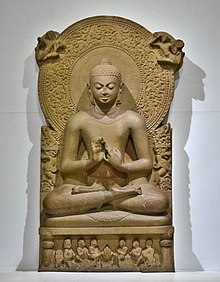Gautama Buddha
| Gautama Buddha | |
|---|---|

A statue of the Buddha from Sarnath, 4th century CE
|
|
| Religion | Buddhism |
| Other names | Siddhartha Gautama, Shakyamuni |
| Personal | |
| Born | c. 563 BCE or c. 480 BCE Lumbini, Shakya Republic (according to Buddhist tradition) |
| Died | c. 483 BCE or c. 400 BCE (aged 80) Kushinagar, Malla Republic (according to Buddhist tradition) |
| Parents |
|
| Senior posting | |
| Predecessor | Kassapa Buddha |
| Successor | Maitreya |
| Gautama Buddha | |||||||||||||||||||||||
| Chinese name | |||||||||||||||||||||||
|---|---|---|---|---|---|---|---|---|---|---|---|---|---|---|---|---|---|---|---|---|---|---|---|
| Chinese | 佛陀 | ||||||||||||||||||||||
|
|||||||||||||||||||||||
| Burmese name | |||||||||||||||||||||||
| Burmese | ေဂါတမ ဗုဒၶ | ||||||||||||||||||||||
| Vietnamese name | |||||||||||||||||||||||
| Vietnamese alphabet | Tất-đạt-đa Cồ-đàm | ||||||||||||||||||||||
| Thai name | |||||||||||||||||||||||
| Thai | พระพุทธเจ้า | ||||||||||||||||||||||
| Korean name | |||||||||||||||||||||||
| Hangul | 부처 | ||||||||||||||||||||||
|
|||||||||||||||||||||||
| Japanese name | |||||||||||||||||||||||
| Kanji | 釈迦 | ||||||||||||||||||||||
| Hiragana | しゃか | ||||||||||||||||||||||
|
|||||||||||||||||||||||
| Bengali name | |||||||||||||||||||||||
| Bengali | গৌতম বুদ্ধ | ||||||||||||||||||||||
| Nepali name | |||||||||||||||||||||||
| Nepali | गौतम बुद्ध | ||||||||||||||||||||||
| Sanskrit name | |||||||||||||||||||||||
| Sanskrit | गौतम बुद्ध | ||||||||||||||||||||||
| Transcriptions | |
|---|---|
| Standard Mandarin | |
| Hanyu Pinyin | Fótuó |
| Bopomofo | ㄈㄛˊ ㄊㄨㄛˊ |
| Wade–Giles | Fo T'o |
| Hakka | |
| Romanization | Sṳt-kâ-mèu-nì |
| Yue: Cantonese | |
| Jyutping | bat6 to4 |
| Southern Min | |
| Hokkien POJ | Sek-khia-mô͘-nî |
| Transcriptions | |
|---|---|
| Revised Romanization | Bu Cheo |
| McCune–Reischauer | Pu Ch'ŏ |
| Transcriptions | |
|---|---|
| Romanization | Shaka |
Gautama Buddha (c. 563 BCE/480 BCE – c. 483 BCE/400 BCE), also known as Siddhārtha Gautama, Shakyamuni Buddha, or simply the Buddha, after the title of Buddha, was an ascetic (śramaṇa) and sage, on whose teachings Buddhism was founded. He is believed to have lived and taught mostly in the eastern part of ancient India sometime between the sixth and fourth centuries BCE.
Gautama taught a Middle Way between sensual indulgence and the severe asceticism found in the śramaṇa movement common in his region. He later taught throughout other regions of eastern India such as Magadha and Kosala.
Gautama is the primary figure in Buddhism. He is recognized by Buddhists as an enlightened or divine teacher who attained full Buddhahood, and shared his insights to help sentient beings end rebirth and suffering. Accounts of his life, discourses, and monastic rules are believed by Buddhists to have been summarized after his death and memorized by his followers. Various collections of teachings attributed to him were passed down by oral tradition and first committed to writing about 400 years later.
Scholars are hesitant to make unqualified claims about the historical facts of the Buddha's life. Most accept that he lived, taught and founded a monastic order during the Mahajanapada era during the reign of Bimbisara (c. 558 – c. 491 BCE), the ruler of the Magadha empire, and died during the early years of the reign of Ajasattu, who was the successor of Bimbisara, thus making him a younger contemporary of Mahavira, the Jain tirthankara. Apart from the Vedic Brahmins, the Buddha's lifetime coincided with the flourishing of influential Śramaṇa schools of thought like Ājīvika, Cārvāka, Jainism, and Ajñana.Brahmajala Sutta records sixty-two such schools of thought. It was also the age of influential thinkers like Mahavira (referred to as 'Nigantha Nataputta' in Pali Canon)), Pūraṇa Kassapa, Makkhali Gosāla, Ajita Kesakambalī, Pakudha Kaccāyana, and Sañjaya Belaṭṭhaputta, as recorded in Samaññaphala Sutta, whose viewpoints the Buddha most certainly must have been acquainted with. Indeed, Sariputta and Moggallāna, two of the foremost disciples of the Buddha, were formerly the foremost disciples of Sañjaya Belaṭṭhaputta, the skeptic; and the Pali canon frequently depicts Buddha engaging in debate with the adherents of rival schools of thoughts. Thus, Buddha was just one of the many śramaṇa philosophers of that time. There is also evidence to suggest that the two masters, Alara Kalama and Uddaka Ramaputta, were indeed historical figures and they most probably taught Buddha two different forms of meditative techniques. While the general sequence of "birth, maturity, renunciation, search, awakening and liberation, teaching, death" is widely accepted, there is less consensus on the veracity of many details contained in traditional biographies.
...
Wikipedia
